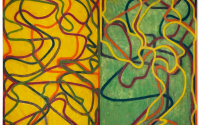Keiichi Tanaami, Artist Who Reinterpreted Pop for a Japanese Audience, Dies at 88
Keiichi Tanaami, an influential artist whose maximalist prints, sculptures, and films utilized the visual language of Pop art to process the trauma faced by postwar Japan, died on August 9 of complications from myelodysplastic syndrome and a sudden subarachnoid hemorrhage. He was 88.
His Japanese gallery, Nanzuka, announced his passing on August 20. Shinji Nanzuka, the gallery’s chief director, said in a statement, “I am sure that Tanaami’s soul will continue to live forever in this paradise that he himself has built, enjoying his time with his wife, friends, and all the strange yet marvelous creatures and monsters that inhabit it.”
Tanaami’s death was also reported by ARTnews’s Japanese affiliate.
During the 1960s and ’70s, Tanaami developed a singular oeuvre that responded to the lingering aftereffects of World War II using a flotilla of symbols and images appropriated from the media. He began producing animations in which Coke bottles became phallic symbols and in which Marilyn Monroe became the Statue of Liberty. No surprise, then, that American Pop artists like Andy Warhol took an interest in Tanaami’s art.
Laced within much of these work, with its bright hues and its ironic humor, was something much darker. His 1975 animation Crayon Angel, for instance, seemed similar to Pop art, as icons associated with Japanese commercial products are quickly edited in throughout. But these pictures appear alongside actual footage of war, infusing all this psychedelica with gloom.
He would go on to continue producing his baroque art up until the very end of his career, memorably exhibiting rhinestone-studded paintings that cobbled together blazing eyes, big-breasted women, figures culled from art-historical paintings, and more at New York’s Venus Over Manhattan gallery in 2022. “I don’t have slumps,” Tanaami told the New York Times that year.
In the end, he would prove himself he right—he died while a retrospective was on view at Tokyo’s National Art Center, with his first American survey set to follow in December at the Institute of Contemporary Art Miami. According to the Nanzuka statement, Tanaami had planned to keep working before his health took a turn for the worse.
Keiichi Tanaami was born in Tokyo in 1936 to a textile shop owner and a homemaker. In 1945, as Tokyo faced heavy bombing from the US, Tanaami’s family moved to Meguro. From Meguro, Tanaami bore witness to air raids and other military actions, many of which would later infiltrate his art years later. He went on to describe an inability to tell which disturbing images he had actually seen and which ones he had imagined.
In the years after World War II, Tanaami became a voracious consumer of American culture, attending screenings of the many Hollywood movies that flowed into Japan. All the Disney films and horror movies that he saw would linger in the back of his mind while he was a design student at Musashino Art University. After graduating, he went into the world of advertising and design.
But he said he found the more traditional corners of that industry “boring,” and instead opted for something more outré. He designed anti–Vietnam War posters and record covers for Jefferson Airplane and the Monkees. And he became first art director of Playboy’s Japanese edition.
The animations and prints he produced bore the clear mark of Pop, but he denied an affiliation with that movement. “I have never thought of myself as a pop artist,” he said in a 2015 interview with Tate Modern, which included his work in a global Pop art survey that year. “However, when I was young there was a time when I was influenced by the methodologies and techniques of pop artists, such as Warhol. Therefore I was perhaps categorised as a pop artist.”
The hallucinations of much of his art ended up being something he experienced firsthand in 1981, when he was hospitalized for tuberculosis. The visions he saw ended up informing his works made in the years afterward, which relied upon placid imagery similar to what’s seen in prints by Hiroshige, then remade it in neon reds and greens.
His phantasmagorical imagery ended up finding a new audience in the field of luxury fashion. Tanaami worked on commission for brands such as Moncler and Stussy, designing T-shirts and jackets.
Some of his final contributions to art history made use of canonical imagery that Tanaami filtered through his own style. During the pandemic, he continually copied Picasso’s “Mother and Child” paintings, occasionally adding manga characters borrowed from Osamu Tezuka’s work. Tanaami told the New York Times that, when he began this project, he “didn’t especially like Picasso.” By the end, however, “I came to love him.”



